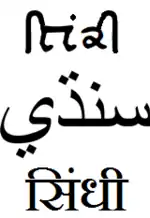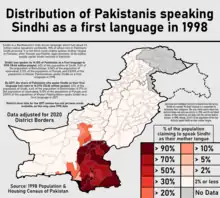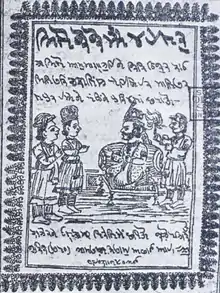Sindhi language
Sindhi (/ˈsɪndi/;[6] سنڌي, सिंधी, ਸਿੰਧੀ, 𑈩𑈭𑈴𑈝𑈮, 𑋝𑋡𑋟𑋐𑋢) is an Indo-Aryan language of the historical Sindh region in the western part of the Indian subcontinent, spoken by the Sindhi people. It is the official language of the Pakistani province of Sindh.[3][4][5] In India, Sindhi is one of the scheduled languages officially recognized by the central government, though Sindhi is not an official language of any of the states in India.[7][8]
| Sindhi | |
|---|---|
| سنڌي, सिन्धी, ਸਿੰਧੀ, 𑈩𑈭𑈴𑈝𑈮, 𑋝𑋡𑋟𑋐𑋢 | |
 Sindhi written in Khudabadi, Perso-Arabic and Devanagari scripts | |
| Native to | Pakistan, India |
| Region | Sindh, Kutch |
| Ethnicity | Sindhis |
Native speakers | 25.5 million (2007)[1] |
Indo-European
| |
| Dialects |
|
| Official status | |
Official language in | |
| Regulated by |
|
| Language codes | |
| ISO 639-1 | sd |
| ISO 639-2 | snd |
| ISO 639-3 | Variously:snd – Sindhilss – Lasisbn – Sindhi Bhil |
| Glottolog | sind1272 Sindhisind1270 Sindhi Bhillasi1242 Lasi |
| Linguasphere | 59-AAF-f |
 Distribution of Pakistanis who spoke Sindhi as their mother tongue at the time of the 1998 Pakistan Census | |
Status and use
The Indian Government has legislated Sindhi as a language of option and a medium of study in India, so that students can choose to learn Sindhi. Sindhi is an optional third language in the Indian states of Rajasthan, Gujarat and Madhya Pradesh.[9]
Prior to the inception of Pakistan, Sindhi was the national language of Sindh.[10][11][12][13] Pakistan Sindh Assemble has ordered compulsory teaching of Sindhi language in all private schools of Sindh.[14] According to the Sindh Private Educational Institutions Form B (Regulations and Control) 2005 Rules, "All educational institutions are required to teach children the Sindhi language.[15] Sindh Education and Literacy Minister, Syed Sardar Ali Shah and Secretary School Education, Qazi Shahid Pervaiz has ordered to employ Sindhi teachers in all private schools in Sindh, so that this language can be easily and widely taught.[16] Sindhi is taught in all province private schools that follow the Matric system and not the ones that follow the Cambridge system.[17]
There are many Sindhi language television channels broadcasting in Pakistan such as Time News, KTN, Sindh TV, Awaz Television Network, Mehran TV and Dharti TV. Besides this, the Indian television network Doordarshan has been asked by the Indian High Court to start a news channel for Sindhi speakers in India.[18][19]
History

The name "Sindhi" is derived from Sindhu, the original name of the Indus River.[20]
Like other languages of this family, Sindhi has passed through Old Indo-Aryan (Sanskrit) and Middle Indo-Aryan (Pali, secondary Prakrits, and Apabhramsha) stages of growth, and it entered the New Indo-Aryan stage around the 10th century CE.[21][22]
In the year 1868, the Bombay Presidency assigned Narayan Jagannath Vaidya to replace the Abjad used in Sindhi, with the Khudabadi script. The script was decreed a standard script by the Bombay Presidency thus inciting anarchy in the Muslim majority region. A powerful unrest followed, after which Twelve Martial Laws were imposed by the British authorities.[23]
According to Sindhi tradition, the first translation of the Quran into Sindhi was completed in the year 883 CE / 270 AH in Mansura, Sindh. The first extensive Sindhi translation was done by Akhund Azaz Allah Muttalawi (1747–1824 CE / 1160–1240 AH) and first published in Gujarat in 1870. The first to appear in print was by Muhammad Siddiq (Lahore 1867).[24]
When Sindh was occupied by British army and was annexed with Bombay, governor of the province Sir George Clerk ordered to make Sindhi the official language in the province in 1848. Sir Bartle Frere, the then commissioner of Sindh, issued orders on August 29, 1857 advising civil servants in Sindh to qualify examination in Sindhi. He also ordered Sindhi to be used in all official communication. Seven-grade education system commonly known as Sindhi-Final was introduced in Sindh. Sindhi Final was made a prerequisite for employment in revenue, police and education departments.[25]
Phonology
Sindhi has a relatively large inventory of both consonants and vowels compared to other languages. Sindhi has 46 consonant phonemes and 16 vowels. The consonant to vowel ratio is around average for world's languages at 2.8.[26] All plosives, affricates, nasals, the retroflex flap and the lateral approximant /l/ have aspirated or breathy voiced counterparts. The language also features four implosives.
Consonants
| Labial | Dental/ alveolar |
Retroflex | (Alveolo-) Palatal |
Velar | Glottal | |||||||
|---|---|---|---|---|---|---|---|---|---|---|---|---|
| Nasal | m م mʱ مھ |
n ن nʱ نھ |
ɳ ڻ ɳʱ ڻھ |
ɲ ڃ |
ŋ ڱ |
|||||||
| Stop/ Affricate |
p پ pʰ ڦ | b ب bʱ ڀ |
t ت tʰ ٿ | d د dʱ ڌ |
ʈ ٽ ʈʰ ٺ | ɖ ڊ ɖʱ ڍ |
tɕ چ tɕʰ ڇ | dʑ ج dʑʱ جھ |
k ڪ kʰ ک | ɡ گ ɡʱ گھ |
||
| Implosive | ɓ ٻ | ɗ ڏ | ʄ ڄ | ɠ ڳ | ||||||||
| Fricative | f ف | s س | z ز | ʂ ش | x خ | ɣ غ | h ھ | |||||
| Approximant | ʋ و |
l ل lʱ لھ |
j ي |
|||||||||
| Rhotic | r ر |
ɽ ڙ ɽʱ ڙھ |
||||||||||
The retroflex consonants are apical postalveolar and do not involve curling back of the tip of the tongue,[28] so they could be transcribed [t̠, t̠ʰ, d̠, d̠ʱ n̠ n̠ʱ ɾ̠ ɾ̠ʱ] in phonetic transcription. The affricates /tɕ, tɕʰ, dʑ, dʑʱ/ are laminal post-alveolars with a relatively short release. It is not clear if /ɲ/ is similar, or truly palatal.[29] /ʋ/ is realized as labiovelar [w] or labiodental [ʋ] in free variation, but is not common, except before a stop.
Vowels

The vowels are modal length /i e æ ɑ ɔ o u/ and short /ɪ̆ ʊ̆ ɐ̆/. (Note /æ ɑ ɐ̆/ are imprecisely transcribed as /ɛ a ə/ in the chart.) Consonants following short vowels are lengthened: [pɐ̆tˑo] 'leaf' vs. [pɑto] 'worn'.
Vocabulary
Sindhi has borrowed from English and Hindustani. Today, Sindhi in Pakistan is slightly influenced by Urdu, with more borrowed Perso-Arabic elements, while Sindhi in India is influenced by Hindi, with more borrowed tatsam Sanskrit elements.[30][31]
Dialects
The dialects of Sindhi include Siroli, Vicholi, Lari, Lasi, Kathiawari Kachhi, Thari or Thareli, Macharia, Dukslinu and Muslim Sindhi.[32][33][34][35][36] The "Siroli or Siraiki" dialect in northern Sindh is distinct from the Saraiki language of South Punjab[37] and has variously been treated either as a dialect of it, or as a dialect of Sindhi.[38] The Sindhi dialects previously known as "Siraiki" are nowadays more commonly referred to as "Siroli".[39]
Writing systems
Written Sindhi is mentioned in the 8th century, when references to a Sindhi version of the Mahabharata appear. However, the earliest attested records in Sindhi are from the 15th century.[21]
Before the standardisation of Sindhi orthography, numerous forms of Devanagari and Lunda (Laṇḍā) scripts were used for trading. For literary and religious purposes, a Perso-Arabic script developed by Abul-Hasan as-Sindi and Gurmukhi (a subset of Laṇḍā) were used. Another two scripts, Khudabadi and Shikarpuri, were reforms of the Landa script.[40][41] During British rule in the late 19th century, the Perso-Arabic script was decreed standard over Devanagari.[42]
Medieval Sindhi devotional literature (1500–1843) comprises Sufi poetry and Advaita Vedanta poetry. Sindhi literature flourished during the modern period (since 1843), although the language and literary style of contemporary Sindhi writings in Pakistan and India were noticeably diverging by the late 20th century; authors from the former country were borrowing extensively from Urdu, while those from the latter were highly influenced by Hindi.[21]
Laṇḍā scripts
Laṇḍā-based scripts, such as Gurmukhi, Khojki and the Khudabadi script were used historically to write Sindhi.
Khudabadi
| Khudabadi or Sindhi | |
|---|---|
| Direction | Left-to-right |
| ISO 15924 | Sind, 318 |
Unicode alias | Khudawadi |
| U+112B0–U+112FF | |
The Khudabadi alphabet was invented in 1550 CE, and was used alongside other scripts by the Hindu community until the colonial era, where the sole usage of the Arabic script for official purposes was legislated.
The script continued to be used in a smaller scale by the trader community until the Partition of India in 1947.[43]
| ə | a | ɪ | i | ʊ | uː | e | ɛ | o | ɔ |
| k | kʰ | ɡ | ɠ | ɡʱ | ŋ | ||||
| c | cʰ | ɟ | ʄ | ɟʱ | ɲ | ||||
| ʈ | ʈʰ | ɖ | ɗ | ɽ | ṛ | ɳ | |||
| t | tʰ | d | dʱ | n | |||||
| p | pʰ | f | b | ɓ | bʱ | m | |||
| j | r | l | ʋ | ||||||
| ʂ | s | h | |||||||
Khojki
Khojki was employed primarily to record Muslim Shia Ismaili religious literature, as well as literature for a few secret Shia Muslim sects.[44]
Gurmukhi
The Gurmukhi script was also used to write Sindhi, mainly in the North of Sindh, and also by Hindu women.[43][45]
Perso-Arabic script
| Sindhi alphabet |
|---|
| ا ب ٻ ڀ پ ت ٿ ٽ ٺ ث ج ڄ جھ ڃ چ ڇ ح خ د ڌ ڏ ڊ ڍ ذ ر ڙ ز س ش ص ض ط ظ ع غ ف ڦ ق ڪ ک گ ڳ گھ ڱ ل م ن ڻ و ھ ء ي |
|
Extended Perso-Arabic script |
During British rule in India, a variant of the Persian alphabet was adopted for Sindhi in the 19th century. The script is used in Pakistan today. It has a total of 52 letters, augmenting the Persian with digraphs and eighteen new letters (ڄ ٺ ٽ ٿ ڀ ٻ ڙ ڍ ڊ ڏ ڌ ڇ ڃ ڦ ڻ ڱ ڳ ڪ) for sounds particular to Sindhi and other Indo-Aryan languages. Some letters that are distinguished in Arabic or Persian are homophones in Sindhi.
| جھ | ڄ | ج | پ | ث | ٺ | ٽ | ٿ | ت | ڀ | ٻ | ب | ا |
|---|---|---|---|---|---|---|---|---|---|---|---|---|
| ɟʱ | ʄ | ɟ | p | s | ʈʰ | ʈ | tʰ | t | bʱ | ɓ | b | ɑː ʔ ∅ |
| ڙ | ر | ذ | ڍ | ڊ | ڏ | ڌ | د | خ | ح | ڇ | چ | ڃ |
| ɽ | r | z | ɖʱ | ɖ | ɗ | dʱ | d | x | h | cʰ | c | ɲ |
| ڪ | ق | ڦ | ف | غ | ع | ظ | ط | ض | ص | ش | س | ز |
| k | q | pʰ | f | ɣ | ɑː oː eː ʔ ∅ | z | t | z | s | ʂ | s | z |
| ي | ء | ھ | و | ڻ | ن | م | ل | ڱ | گھ | ڳ | گ | ک |
| j iː | ʔ ∅ | h | ʋ ʊ oː ɔː uː | ɳ | n | m | l | ŋ | ɡʱ | ɠ | ɡ | kʰ |

Devanagari script
In India, the Devanagari script is also used to write Sindhi.[46] A modern version was introduced by the government of India in 1948; however, it did not gain full acceptance, so both the Sindhi-Arabic and Devanagari scripts are used. In India a person may write a Sindhi language paper for a Civil Services Examination in either script . Diacritical bars below the letter are used to mark implosive consonants, and dots called nukta are used to form other additional consonants.
| अ | आ | इ | ई | उ | ऊ | ए | ऐ | ओ | औ |
|---|---|---|---|---|---|---|---|---|---|
| ə | a | ɪ | i | ʊ | uː | e | ɛ | o | ɔ |
| क | ख | ख़ | ग | ॻ | ग़ | घ | ङ | ||
| k | kʰ | x | ɡ | ɠ | ɣ | ɡʱ | ŋ | ||
| च | छ | ज | ॼ | ज़ | झ | ञ | |||
| c | cʰ | ɟ | ʄ | z | ɟʱ | ɲ | |||
| ट | ठ | ड | ॾ | ड़ | ढ | ढ़ | ण | ||
| ʈ | ʈʰ | ɖ | ɗ | ɽ | ɖʱ | ɽʱ | ɳ | ||
| त | थ | द | ध | न | |||||
| t | tʰ | d | dʱ | n | |||||
| प | फ | फ़ | ब | ॿ | भ | म | |||
| p | pʰ | f | b | ɓ | bʱ | m | |||
| य | र | ल | व | ||||||
| j | r | l | ʋ | ||||||
| श | ष | स | ह | ||||||
| ʂ | ʂ | s | h | ||||||
Gujarati script
The Gujarati script is used to write the Kutchi Language in India.[47]
Roman Sindhi
The Sindhi-Roman script or Roman-Sindhi script is the contemporary Sindhi script usually used by the Sindhis during texting messages on their mobile phones.[48][49]
Computing resources
Sindhi language software such as Sindhi language keyboards have been developed for the Windows OS, Android smartphones. Various other online websites provide Sindhi keyboard such as (Keymanweb.org),[50][51] M.B Sindhi keyboard by Abdul Razaque & Abdul-Majid Bhurgri. Software has also been developed for the transliteration between the main writing systems.[52][53] A transliteration website also exists on the internet that can transliterate between different scripts of Sindhi language (including the newly proposed Latin Script[54][55][56]) and the website's source code is openly available on GitHub for anyone to view and use anywhere.
See also
References
- Nationalencyklopedin "Världens 100 största språk 2007" The World's 100 Largest Languages in 2007
- "Script". Sindhilanguage.com.
- Majeed, Gulshan. "Ethnicity and Ethnic Conflict in Pakistan" (PDF). Journal of Political Studies. Retrieved December 27, 2013.
- "Sindhi". The Languages Gulper. Retrieved December 27, 2013.
- "Encyclopædia Britannica". Sindhi Language. Retrieved December 29, 2013.
- Laurie Bauer, 2007, The Linguistics Student’s Handbook, Edinburgh
- "Languages Included in the Eighth Schedule of the Indian Constution". Department of Official Language, Ministry of Home Affairs. Retrieved 2018-04-09.
- "Sindhi Language, Sindhi Dialects, Sindhi Vocabulary, Sindhi Literature, Sindhi, Language, History of Sindhi language". Indian Mirro. Retrieved 2018-04-09.
- "National Committee for Linguistic Minorities" (PDF). Archived from the original (PDF) on 2012-05-13. Retrieved 2018-08-13.
- Language and Politics in Pakistan. "THE SINDHI LANGUAGE MOVEMENT 103 103 7The Sindhi Language Movement". academia.edu. Retrieved 12 September 2015.
- "The Imposition Of Urdu". NAWAIWAQT GROUP OF NEWSPAPERS. September 10, 2015. Retrieved 12 September 2015.
- "Microsoft Word - Teaching of Sindhi & Sindhi ethnicity.doc" (PDF). Retrieved 2018-08-13.
- "404 – tariqrahman" (PDF). tariqrahman.
- Samar, Azeem."PA resolution calls for teaching Sindhi as compulsory subject in private schools", The News,March 13, 2019
- "Sindhi to be made compulsory in all private schools across province", Pakistan Today,September 25, 2018
- "Private schools directed to make Sindhi compulsory subject", Dawn,September 25, 2018
- "Sindh private schools told to teach Sindhi as compulsory subject","Samaa",September 24, 2018
- "24hr news channel for Sindhis: HC seeks Centre's response". Business Standard Private Ltd. Press Trust of India. September 4, 2015. Retrieved 12 September 2015.
- "Sindhi". Accredited Language Services. Retrieved 7 May 2016.
- "Sindhi". The Languages Gulper. Retrieved January 29, 2013.
- "Encyclopædia Britannica". Retrieved May 11, 2013.
- "Sindhi - About World Languages".
- "Sindhi alphabets, pronunciation and language". Omniglot.com.
- "The Holy Qur'an and its Translators -- Imam Reza (A.S.) Network". imamreza.net. Archived from the original on 15 January 2016. Retrieved 29 March 2015.
- Memon, Naseer (April 13, 2014). "The language link". The News on Sunday. Retrieved April 13, 2014.
- Nihalani, Paroo. (1999). Handbook of the International Phonetic Association (Sindhi). Cambridge: Cambridge University Press.
- Nihalani, Paroo (December 1, 1995). "Illustration of the IPA - Sindhi". Journal of the International Phonetic Association. 25 (2): 95–98. doi:10.1017/S0025100300005235.
- Nihalani 1974, p. 207.
- The IPA Handbook uses the symbols c, cʰ, ɟ, ɟʱ, but makes it clear this is simply tradition and that these are neither palatal nor stops, but "laminal post-alveolars with a relatively short release". Ladefoged & Maddieson (1996:83) confirm a transcription of [t̠ɕ, t̠ɕʰ, d̠ʑ, d̠ʑʱ] and further remarks that "/ʄ/ is often a slightly creaky voiced palatal approximant" (caption of table 3.19).
- Cole (2001:652–653)
- Khubchandani (2003:624–625)
- Sindhi language at Ethnologue (19th ed., 2016)
- Austin, Peter; Austin, Marit Rausing Chair in Field Linguistics Peter K. (2008). One Thousand Languages: Living, Endangered, and Lost. University of California Press. ISBN 9780520255609.
- Paniker, K. Ayyappa (1997). Medieval Indian Literature: Surveys and selections. Sahitya Akademi. ISBN 9788126003655.
- "Sindhi Language, Sindhi Dialects, Sindhi Vocabulary, Sindhi Literature, Sindhi, Language, History of Sindhi language". www.indianmirror.com. Retrieved 2019-09-24.
- Parekh, Rauf (2008-09-30). "The Sindhi language and its variations". DAWN.COM. Retrieved 2019-09-24.
- Masica, Colin P. (1991). The Indo-Aryan languages. Cambridge language surveys. Cambridge University Press. p. 443. ISBN 978-0-521-23420-7.
- Rahman, Tariq (1995). "The Siraiki Movement in Pakistan". Language Problems & Language Planning. 19 (1): 3. doi:10.1075/lplp.19.1.01rah.
- Shackle 2007, p. 114.
- Khubchandani (2003:633)
- "Ancient Scripts: Landa".
- Cole (2001:648)
- "Sindhi Language: Script". Retrieved 15 May 2012.
- http://std.dkuug.dk/jtc1/sc2/wg2/docs/n3978.pdf
- http://std.dkuug.dk/JTC1/SC2/WG2/docs/n3871.pdf
- p.2 Proposal to Encode the Sindhi Script in ISO/IEC 10646
- "Gujarati alphabet, pronunciation and language". omniglot.com. Retrieved 29 March 2015.
- "Romanized Sindhi". Romanized Sindhi.org. Retrieved 7 May 2016.
- "CHOICE OF SCRIPT FOR OUR SINDHI LANGUAGE". Chandi Ramani. Retrieved 7 May 2016.
- "Sindhi - Keyboards - Tavultesoft".
- "KeymanWeb.com - Type to the world in your language".
- Z .Ali (September 19, 2014). "Transcending barriers: Software to break down the wall within the Sindhi language". The Express Tribune. Retrieved 7 May 2016.
- Amaninder Sharma (September 3, 2014). "Software to melt India, Pakistan's Sindhi script barrier". Times of India. Retrieved 7 May 2016.
- "Sindhi – its Latin script – and the way forward!". Hard Hour. 2020-04-26. Retrieved 2020-05-17.
- "Latin Sindhi". omniglot.com. Retrieved 2020-05-17.
- "A new script for Sindhi Language!". fahadmaqsood.github.io. Retrieved 2020-05-17.
Sources
- Nihalani, Paroo (1974). "Lingual Articulation of Stops in Sindhi". Phonetica. 30 (4): 197–212. doi:10.1159/000259489. ISSN 1423-0321. PMID 4424983.
- Addleton and Brown (2010). Sindhi: An Introductory Course for English Speakers. South Hadley: Doorlight Publications. Archived from the original on 2010-08-28. Retrieved 2010-03-18.
- Bughio, M. Qasim (January–June 2006). Maniscalco, Fabio Maniscalco (ed.). "The Diachronic Sociolinguistic Situation in Sindh". Web Journal on Cultural Patrimony. 1.
- Cole, Jennifer S (2001). "Sindhi". In Garry, Jane; Rubino, Carl (eds.). Facts About the World's Languages. H W Wilson. pp. 647–653. ISBN 0-8242-0970-2.
- International Phonetic Association. 1999. ISBN 0-521-63751-1.
- Khubchandani, Lachman M (2003). "Sindhi". In Cardona, George; Jain, Dhanesh (eds.). The Indo-Aryan Languages. Routledge. pp. 622–658. ISBN 978-0-415-77294-5.
- Ladefoged, Peter; Maddieson, Ian (1996). The Sounds of the World's Languages. Oxford: Blackwell. ISBN 978-0-631-19815-4.
- Shackle, Christopher (2007). "Pakistan". In Simpson, Andrew (ed.). Language and national identity in Asia. Oxford linguistics Y. Oxford University Press. ISBN 978-0-19-922648-1.
- Trumpp, Ernest (1872). Grammar of the Sindhi Language. London: Trübner and Co. ISBN 81-206-0100-9.
- Chopra, R. M (2013). "Persian in Sindh". The rise, growth, and decline of Indo-Persian literature (2nd ed.). New Delhi: Iran Culture House. OCLC 909254259.
External links
| Sindhi edition of Wikipedia, the free encyclopedia |
| Wikivoyage has a travel guide for Sindhi phrasebook. |
| Wikimedia Commons has media related to Sindhi language. |
| Wikisource has the text of a 1911 Encyclopædia Britannica article about Sindhi language. |
- Sindhi Language Authority
- Sindhi Dictionary
- All about Sindhi language and culture at the Wayback Machine (archived August 31, 2015)
- Wals.info
- Sindhi computing resources at world's first Sindhi website by Majid Bhurgri (Arabic script)
- Sindhi computing resources at TDIL (Arabic script)
- Sindhi computing resources at TDIL (Devanagari script)
- Mewaram's 1910 Sindhi-English dictionary